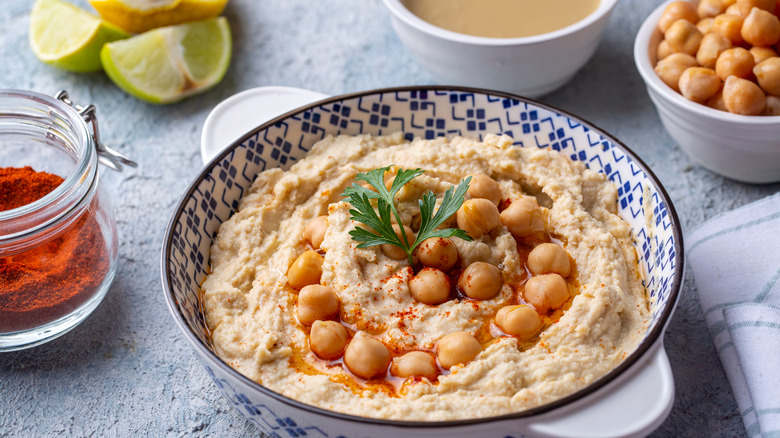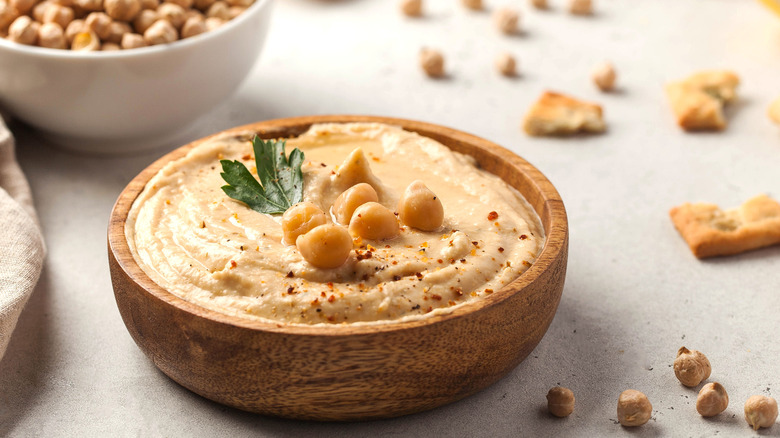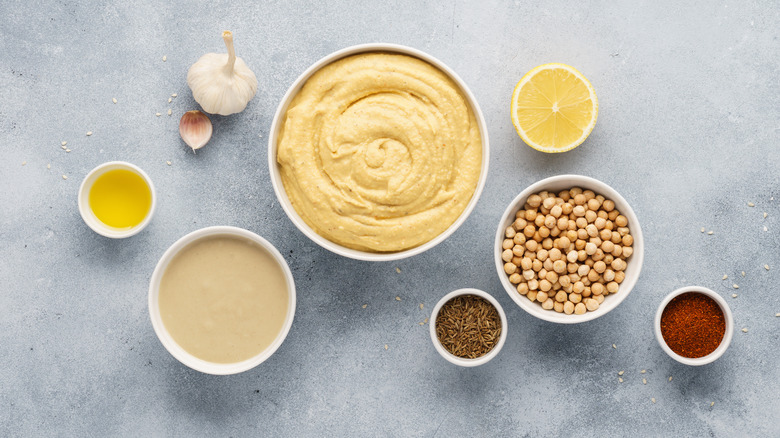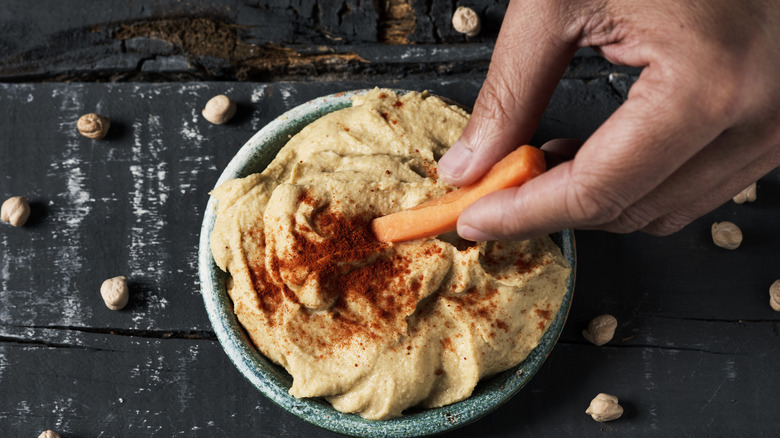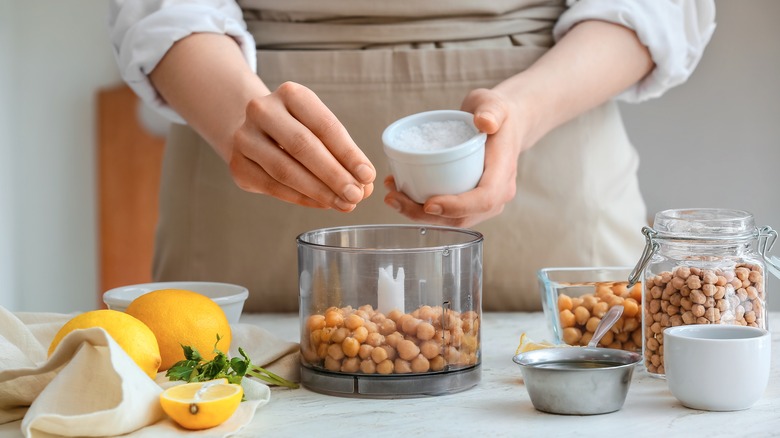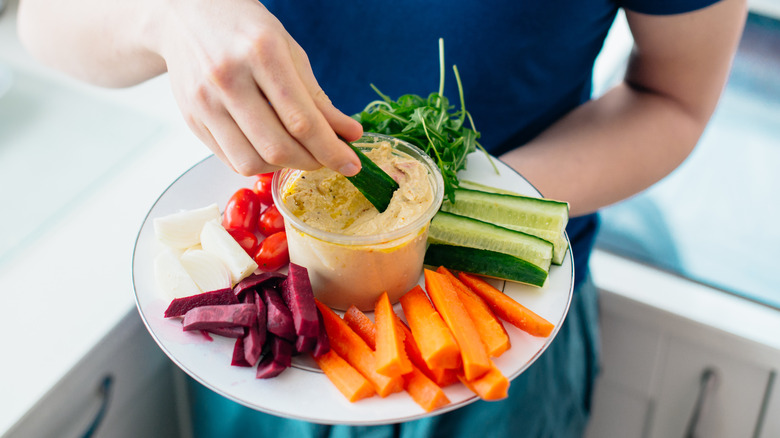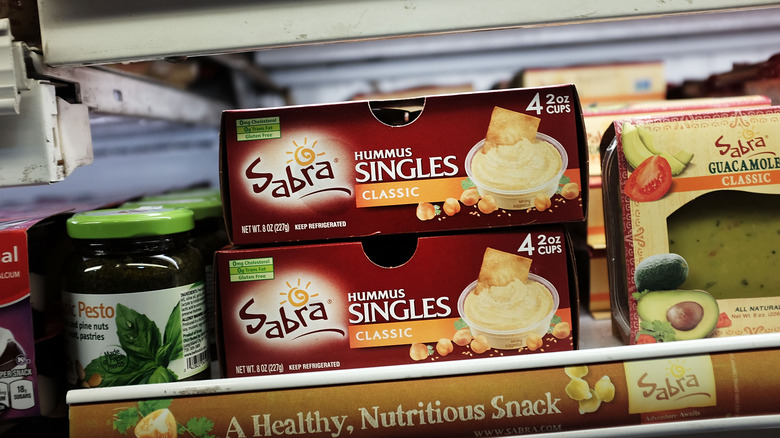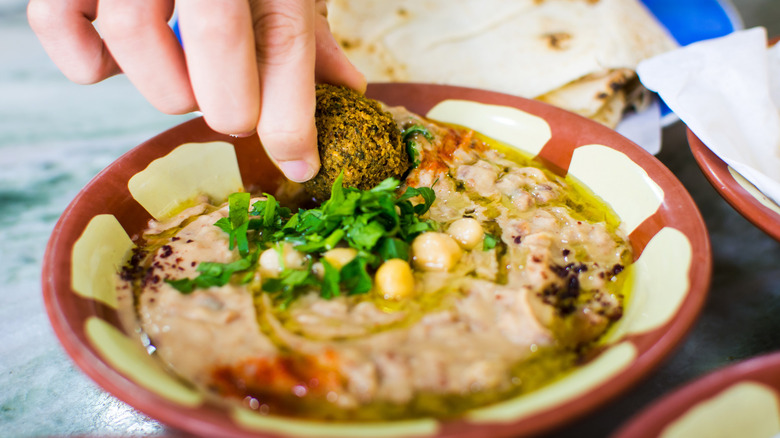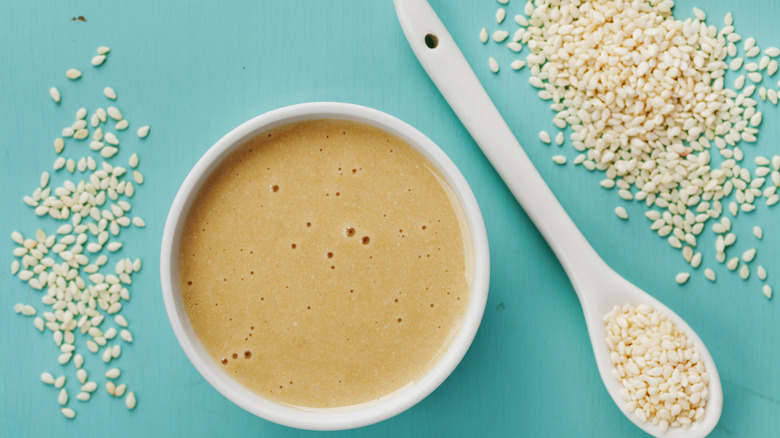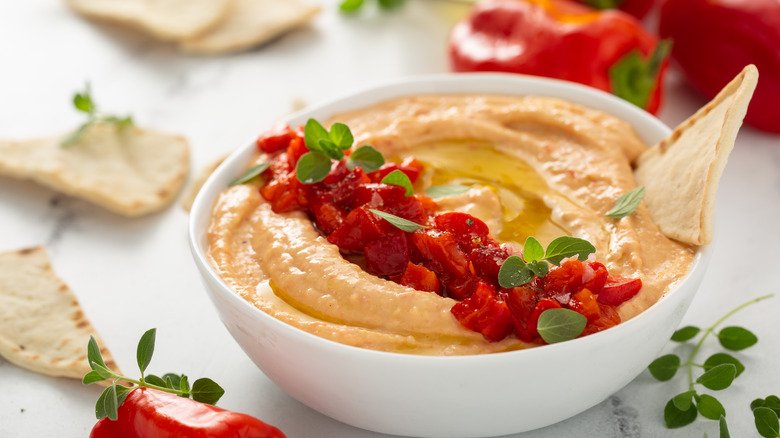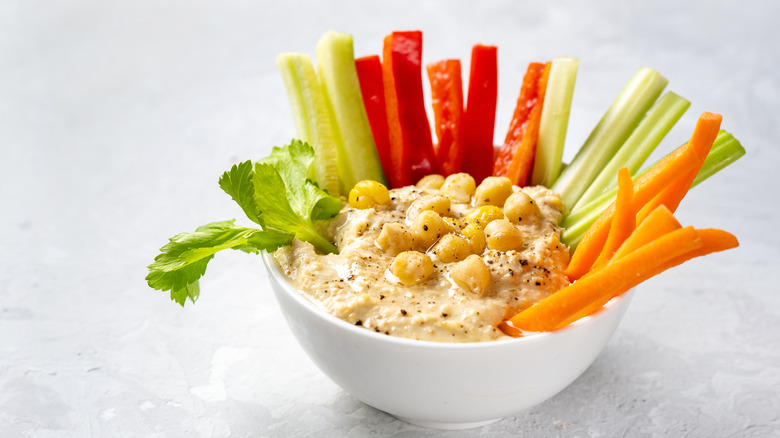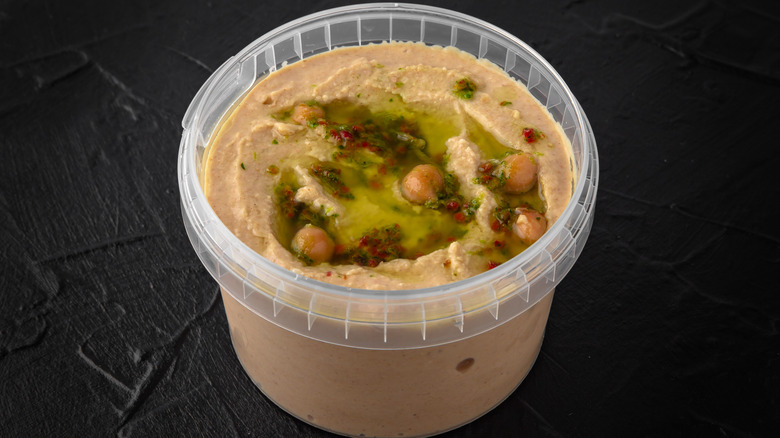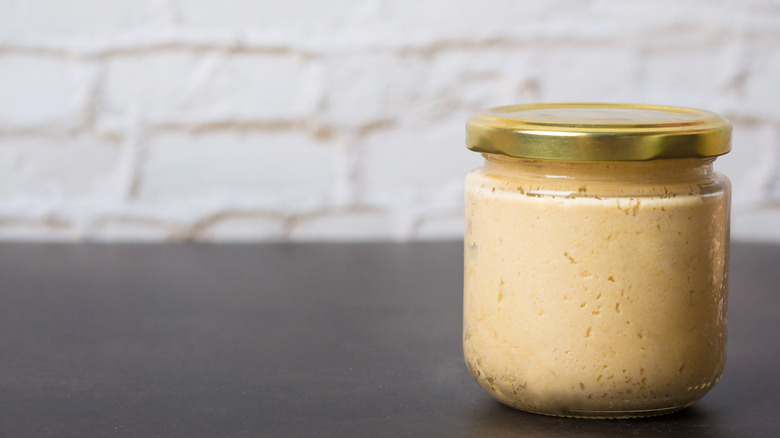What Exactly Is Hummus, And Where Did It Originate?
You've seen it on the menu at Greek and Middle Eastern restaurants, you've walked by it on the shelves at the grocery stores, and maybe you've even tried it a few times, but do you really know what exactly hummus is? Or, for that matter, do you know where it came from? Hummus is often served as a dip with vegetables or pita chips, but it is also used as a spread for sandwiches and burgers, a sauce for different kinds of pasta, a dressing for salads, and more.
If you've never tried hummus before or have had it a few times but aren't exactly sure what you're eating, you've come to the right place. There's so much to know about hummus, from its origins, the ingredients needed to make it, what it tastes like, and more. Once you truly delve into all the information about hummus, you'll likely have found the answers to all of your burning questions about hummus and will be ready to decide if it is something you think you'll enjoy.
What is hummus?
Hummus is a puréed mixture made from chickpeas and a few other key ingredients. While the ingredients may vary slightly with different variations, they typically include olive oil, tahini, and lemon juice. The mixture has a very smooth consistency, which is why it is so often used as a dip or spread. Because of these ingredients, hummus is light brown in color. At first glance, it could be confused with peanut butter or other spreads, but the consistency isn't anywhere near as thick or sticky.
You can find hummus at the grocery store. It is also commonly served at many different restaurants, particularly Mediterranean and Middle Eastern restaurants. But it is also very easy to make your own hummus. So, if you decide to try it and get a hankering for it, you can always whip up a fresh batch to enjoy or share with friends and family.
Where did hummus originate?
Let us step back a few hundred years and take a look at the origins of this now-popular dish. According to history books, the first time hummus recipe was written down in the 13th century. It is not completely clear exactly which country gave us hummus. It is such an integral part of the cuisine in many regions, including the Middle East, the Mediterranean, and North Africa, and several of the countries in these regions credit themselves with its initial creation. However, many people believe that this dish originated in ancient Egypt.
The name "hummus," which you may also see spelled hommus, humus, houmous, or hommos, is the Arabic word for chickpea, the star ingredient in the dish. During the time hummus was first created (and today), there were lots of chickpeas growing in the Middle Eastern and Mediterranean regions. Their abundance seems to have inspired someone to grind them up and make the first batch of hummus, which has grown into a dish that many of us now know and love.
Which ingredients do you need to make it?
While there are several variations of hummus, let's take a look at the ingredients you'll need to make plain hummus. They include chickpeas, tahini, olive oil, garlic, lemon, salt, and pepper. You've likely heard of most of these ingredients, but there may be a few that you're unfamiliar with. First and foremost, you need chickpeas to make hummus. Chickpeas, which are also called garbanzo beans, are a legume that is derived from the same family as black beans and lima beans. If you want to make your own hummus, starting with canned chickpeas will be the easiest option, but you can also try cooking dried chickpeas yourself to make the base of the recipe.
The other ingredient in hummus that many haven't heard of is tahini. Tahini is made by grinding sesame seeds into a creamy paste. If you haven't seen it at your grocery store, try looking in the international aisle. In addition to the chickpeas and tahini, you'll also need olive oil (look for extra virgin olive oil, or EVOO as it is sometimes called), lemon juice (fresh-squeezed), garlic (choose fresh over powdered, when possible), and a little salt and pepper.
What does it taste like?
So, what does hummus taste like? This can be a bit challenging to describe if you haven't tried some of the key ingredients found in the dish before. However, at the same time, the combination of the various ingredients results in a distinct and unique taste that you couldn't achieve without mixing everything together. Texture plays a huge role in how something tastes and whether you will enjoy it, so let's start there when discussing hummus. The texture is very smooth and creamy. When prepared correctly, hummus shouldn't have any chunks of chickpeas or any other ingredients: It should be perfectly smooth.
Now, for its taste: Hummus has a rich and slightly tangy taste. The exact ratio of seasonings, particularly garlic, will determine precisely how much kick it has. However, you shouldn't expect it to be hot or spicy, just that bit of a kick from the garlic. The addition of tahini also imparts a hint of nuttiness to the overall flavor profile, while the lemon juice gives it a slightly tangy taste.
How do you make hummus?
Gathering the ingredients you'll need to make hummus is half the battle. So, before you plan to try your hand at making your own hummus, start by gathering everything you'll need: Canned chickpeas (unless you plan on cooking dried chickpeas), tahini, garlic, olive oil, lemon juice, salt, and pepper. The best way to achieve the creamy texture of hummus is to use your blender or food procedure; you want to basically purée the ingredients.
Once you have all of your ingredients laid out, start by adding the tahini and lemon juice to a blender. Purée until nice and creamy, which should take about 1 minute. Next, add the olive oil, garlic, salt, and pepper to the blender and continue puréeing for about 30 to 45 seconds. Verify that everything looks smooth and that there are no large chunks of garlic before moving on. Finally, pour the chickpeas (drained) into the blender. Turn it on for about a minute and a half until smooth and well-blended. Check the consistency, and add a splash of water or a bit more olive oil if it is too thick.
What can you eat with it?
The possibilities are nearly endless when it comes to serving hummus and what you can eat with it. It's often served as a dip. Try dipping pita chips, carrots, celery, cucumber, peppers, and other raw veggies in it. Another popular way to use hummus is as a spread on a sandwich or burger. Add your favorite veggies, such as avocado, roasted red peppers, pickled onions, cucumbers, carrots, olives, and vegetable sprouts.
You could add some meat, such as lamb, chicken, or beef, or you could keep the sandwich vegetarian. Hummus can also be used as a sauce for a bowl with rice (or other grains). Add in your favorite grain, some vegetables, some meat, and a few spoonfuls of hummus. Mix everything together and enjoy. You can even turn hummus into a dessert dip by adding some chocolate to the recipe and using it to dip apples, pineapple, pretzels, and more.
Where can you get it?
If hummus sounds good to you, then the first question you might be asking may be, "Where can I get hummus?" Fortunately, even though hummus did not originate in the United States, it has become very popular here. Unlike some other specialty dishes that are popular in other cultures, you can find hummus with ease at just a regular grocery store. While every grocery store uses a unique layout and the precise placement of hummus will vary, there are a few key places you can start your search.
First, hummus must be refrigerated, so you will find it in a refrigerated second. Often, it will be close to the produce area, but sometimes it may be kept closer to the deli, cheese aisle, or prepared foods section. Beyond making your own batch of hummus, the other option you'll have if you want to try it right away is to head to a restaurant that makes hummus. Again, because of its popularity, hummus is available on many restaurant menus, namely those for Mediterranean and Middle Eastern restaurants. You may even be able to find it on some "American" menus because of how many people enjoy it.
What health benefits does hummus offer?
Hummus, in addition to being so tasty, is actually good for you. The key ingredients in the dish include a mix of essential vitamins that can do wonders for your health. First, each serving of the dish offers up to 7.9 grams of protein. This can help you feel more satisfied after a meal or snack, and it is especially good for those looking for protein-rich meat alternatives. Hummus is a fiber-rich food. When your body gets enough dietary fiber, it can help keep your digestive tract healthy and aid in regularity. Those with a diet higher in fiber may also have increased healthy bacteria in their gut, which is important for proper bodily functioning.
Hummus can also help reduce inflammation. Olive oil, one of the ingredients found in hummus, includes antioxidants that fight inflammation. Sesame seeds (in tahini) and chickpeas have also been connected with lower levels of inflammation. The ingredients have also been linked with reducing the risk of heart disease, lowering blood sugar levels, and aiding in weight loss. It's just an all-around good food to work into your diet.
Does it have any allergens?
If you're looking for nut-free snacks, you'll be happy to hear that there are no nuts in hummus. So, it should be safe for anyone with a tree nut or peanut allergy to eat (of course, always check for the potential of cross-contamination during the manufacturing process, or make your own to eliminate any questions about whether an allergen could accidentally be present). However, while they are not as common as nut allergies, some people could be allergic to some of the other ingredients used to make hummus.
Several people are allergic to sesame. Since tahini is made using sesame seeds, anyone with a sesame allergy should stay away from hummus or make their own tahini-free version. Chickpeas can also cause an allergic reaction in some people. While the allergic reaction is likely to be less severe with cooked chickpeas, such as those used for hummus, than their raw counterparts, it still holds the potential to be quite serious. Anyone who is allergic to chickpeas should avoid eating hummus.
Is it an aphrodisiac?
Have you heard rumors that hummus is an aphrodisiac? There certainly are several bizarre aphrodisiacs around the world, but is hummus actually one of them? Well, many people do classify hummus as an aphrodisiac. There are several ingredients in hummus that work together to help it increase one's sex drive. One of these components is vitamin B6. It works to keep a woman's sex hormones regulated and also keep estrogen production under control. These two features lead to an increased libido.
The garlic found in hummus may also help increase your sex drive. One of the compounds in garlic is allicin. It is known to increase the flow of blood, a key for revving up one's interest in having sex. Olives (and thereby olive oil) have been viewed as an aphrodisiac in the Mediterranean for ages. Like garlic, they are known to help increase the flow of blood throughout the body thanks to their monounsaturated fats and oleic acid.
Are there different variations of hummus?
There are several different variations to the traditional hummus recipe. Once you know how to make plain hummus, it is easy to add in a few new flavors to change up the way it tastes or create something unique to serve guests. For example, increase the garlic content by adding in a head of roasted garlic to create a roasted garlic hummus. Want to kick thinking up a notch? Add a chipotle pepper with the other ingredients before blending them, and voilà, you've got chipotle hummus.
The possibilities are pretty much endless. Just think about your favorite flavors and the way you plan to use the hummus, and you can come up with some new ingredients to add to the mix. Adding everything from sweet potatoes to chocolate is possible, and yes, people really do make chocolate hummus to enjoy as a dessert. You can even swap out some or all of the garbanzo beans for white beans or another variety to really change the way it tastes.
Is it vegan?
One of the best things about hummus is that vegetarians and vegans can enjoy it too. Unlike so many other recipes that you'll need to alter by removing meat or cheese to enjoy, hummus is vegan-friendly just as it is. The classic recipe featuring chickpeas, tahini, olive oil, garlic, lemon juice, salt, and pepper does not include any animal-derived products. For that matter, many hummus variations add in other vegetables but not dairy or meat products, so they'll generally be safe as well.
As always, it is a good idea to verify the ingredients in a store-bought product before diving in and enjoying it. If you're ordering hummus from a restaurant, you can ask to verify that it does not include any animal-based products as well. Where you'll need to be most careful is likely when looking at recipes that are made with hummus, such as wraps, sandwiches, or platters. These are more likely to include meat or cheese that you'll want to avoid.
How long does it last in the refrigerator?
The length of time hummus lasts will vary depending on whether it is homemade or store-bought. Generally, store-bought hummus will last the longest, and it'll remain good for about one week after being opened. If you make your own hummus, you should aim to use it up within about 4 days. After that time, it will start to go bad and may not taste as good. As a reminder, always store hummus in the refrigerator; it should not be consumed if left out of the fridge for too long.
The reason that store-bought hummus tends to last a bit longer than homemade recipes is because of the preparation process. Hummus manufacturing plants are sterile, which prevents even minor contamination. Even if your kitchen is clean, it won't be as sterile as a manufacturing plant, and it is possible that some bacteria or another substance will be introduced into your hummus, causing it to go bad faster.
How do you freeze hummus?
If you don't think you'll use up your hummus before it goes bad, you can freeze it to extend its lifespan. In fact, while refrigerated hummus will only last a few days, properly frozen hummus can last for up to eight months. There are a few key things to keep in mind when freezing hummus. The first is that you must freeze it in an airtight container. If the container you use isn't airtight and designed for the freezer, then air will get in, causing freezer burn. This will have a negative impact on the way the hummus tastes when you're ready to take it out and enjoy it.
The second key thing to think about when freezing hummus is that it is better to freeze it in small batches. This way, you can take out just as much hummus as you'd like without worrying about it going to waste. A smaller container of hummus will also thaw and be ready to enjoy more quickly than a larger one. Try to remove hummus from your freezer the night before you plan to use it to give it sufficient time to defrost. Never thaw hummus (or any other foods) out on the counter or in hot water; it is just asking for bacteria to start growing. Once thawed, the oil may have separated, so just give the hummus a good stir before eating it.
